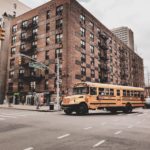 Universities can often be the hub of local business ecosystems. Recent research from Stanford explains how lower down the food chain, schools can play a similar role in local communities, so the closure of a school can have a dramatic impact.
Universities can often be the hub of local business ecosystems. Recent research from Stanford explains how lower down the food chain, schools can play a similar role in local communities, so the closure of a school can have a dramatic impact.
The authors explain that school closures are often framed in terms of their impact on the education of students, who are forced to travel to other schools and often suffer from larger class sizes. The research finds, however, that the closures also change the landscape of their local community, and can often have a particularly harmful impact if the closure occurs in Black neighborhoods.
Neighborhood impact
The researchers used census data and statistics on school closures to explore how closures affected things such as the rate and spread of gentrification in a neighborhood. The results suggest that closures help to accelerate gentrification, but only in predominantly Black neighborhoods.
“School closures are one of the most politically fraught issues in urban school reform today,” the authors say. “This study sheds new light on the consequences of these closures, in particular for the future of Black communities.”
The authors believe there is a considerable gap in the existing research around the impact school closures have on the surrounding neighborhoods.
“There’s been a fair amount of research on the effect school closures have on student achievement, but very little on what they mean for communities,” they explain. “The evidence we had was largely anecdotal.”
Closing down
The researchers combined several national datasets to understand the impact every urban school closure had between 2000 and 2012. Combining this with census data allowed them to examine the changes in the characteristics of individual neighborhoods across this timeframe to explore any gentrification that took place.
This gentrification was determined as occurring if the community had a median income and a share of recently constructed housing below the 50th percentile in their city; it saw an increase in house prices during the study period; and also an increase in the number of college-educated households that exceeded any increases seen across the city as a whole.
The results show that school closures had a significant increase in the chances of gentrification of a neighborhood, with the chances rising from 19% to 27%. Interestingly, however, this was only really found in Black communities. The authors argue that when schools close in Black communities, it seemed to increase the residential desirability of the surrounding area in a way that wasn’t observed for other community facilities.
Jump starting gentrification
The researchers speculate that this trend could be due to the generally low regard predominantly Black schools might be held in within their local community due to their general economic disadvantages.
“Affluent folks generally aren’t dissuaded from moving into low-income white or Latinx neighborhoods on account of the local schools,” they say. “Schools in white and Latinx neighborhoods, even if they’re low-performing, are still perceived as options because they aren’t Black.”
By contrast, when schools closed in low-income white neighborhoods, it actually lowered the chances of gentrification by around 3%, which underlines the honeypot effect good schools can have in a neighborhood when people are mobile enough. Black schools, on the other hand, can often act as a kind of safeguard against gentrification in disinvested parts of town.
“When schools in Black neighborhoods remain open, surrounding areas are unlikely to experience gentrification,” he says. “This is partly due to the fact that affluent households, especially affluent white households, are unlikely to enroll their children at majority Black schools, regardless of their quality.”
The researchers hope that by highlighting the impact school closures have on their neighborhoods, and on gentrification specifically, they can help to better inform policy makers of how educational decisions can influence urban inequality and even the dispossession of communities of color.
“School closures are emblematic of a larger spatial and racial reimagining of US cities,” the authors conclude. “In an era where school districts are writing statements and promising policy in ‘defense of Black lives,’ this study is a reminder that school closures, as an educational reform strategy, can materially contribute to the disintegration of Black communities.”